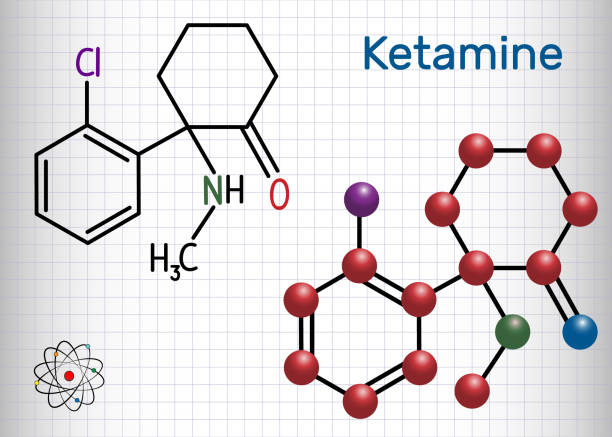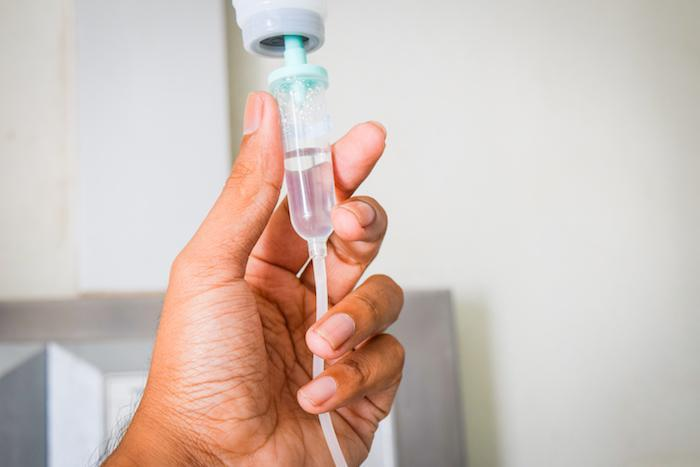Ketamine Infusion vs. Esketamine nasal spray: A Comparison of Two Innovative Treatments for Depression
The search for effective treatments for depression and mood disorders has led to the emergence of innovative options such as ketamine therapy. Ketamine works differently to conventional antidepressant medications to treat depression, such as selective serotonin reuptake inhibitors, an oral antidepressant. Ketamine infusion is given via a drip and Spravato (esketamine hydrochloride) is given as a nasal spray.
Ketamine treatment has shown promise in alleviating symptoms of depression, particularly for patients with treatment-resistant depression and more severe depression. This article will compare and contrast ketamine infusion and Spravato (esketamine), examining their mechanisms of action, administration methods, efficacy, side effects, and overall suitability as treatments for depression.
Mechanism of Action
Ketamine Infusion
Ketamine is a dissociative anesthetic that acts primarily as an N-methyl-D-aspartate (NMDA) receptor antagonist. Its antidepressant effects are believed to result from its action involving nmda receptor antagonism and increases the release of glutamate, which subsequently enhances neuroplasticity and promotes the growth and repair of neural connections. Some research also suggests that ketamine acts on opioid receptors (the receptors that opioid painkillers act on) to produce its antidepressants effect.

Spravato (Esketamine)
Spravato is a nasal spray containing esketamine, the S-enantiomer of ketamine (as compared with racemic ketamine). Like ketamine, esketamine acts as an NMDA receptor antagonist and is thought to exert its antidepressant effects through a similar increase in glutamate release and enhancement of neuroplasticity.

Administration Methods
Ketamine Infusion

Ketamine is typically administered intravenously via an infusion pump in a controlled clinical setting, with patients receiving a series of infusions over a few weeks. The dose and frequency of infusions are determined based on individual patient needs and response to treatment. The dose is administed over a period of time, not as bolus doses. These are lower doses for major depression than what is used when ketamine is given for anaesthesia.
Spravato (Esketamine)

Spravato (esketamine) is a self-administered nasal spray, used under the supervision of a healthcare professional in a certified treatment centre. Patients typically receive Spravato (esketamine) twice a week for the first month, followed by a reduced frequency during the maintenance phase.
Efficacy
Both ketamine infusion and Spravato (esketamine) have demonstrated efficacy in reducing symptoms of depression in major depressive disorder, particularly treatment resistant depression, when other conventional antidepressant medication has failed. One of their advantages as a treatment for depression is their rapid antidepressant effect when compared with conventional antidepressants.
Ketamine Infusion
Multiple studies have shown that ketamine infusions can provide rapid and significant relief from depressive symptoms, often within hours of administration and after a single dose, in treatment resistant depression. It has show benefit in major depression including unipolar depression and bipolar depression. Ketamine in less robust studies have shown to reduce suicidal ideation/suicidal thoughts. The duration of benefit varies between individuals, days to several weeks, and so it is likely that maintenance treatments are needed to maintain the benefit.
Spravato (Esketamine)
Clinical trials of Spravato (esketamine) have also demonstrated its efficacy to treat depression and in reducing depressive symptoms, with some patients experiencing improvements within hours of administration. The duration of the antidepressant effects in the treatment for depression varies between individuals, but similarly likely requires maintenance treatment with repeated dosing to maintain any benefits.
Side Effects of ketamine vs esketamine (spravato)
Both ketamine infusion and Spravato (esketamine) can cause side effects, like other drugs, which may differ in severity and duration. When used in the treatment for depression (cf. with anaesthesia, which uses larger doses) the doses are much lower and therefore the adverse effects of ketamine can be reduced.
Ketamine Infusion
Common side effects of ketamine infusion include dissociation, dizziness, nausea, increased blood pressure, and elevated heart rate. These side effects are usually short-lived and resolve after the infusion is complete.
Spravato (Esketamine)
Spravato (esketamine) can cause side effects similar to ketamine infusion, such as dissociation, dizziness, and increased blood pressure. Additionally, some patients may experience nasal discomfort or irritation due to the nasal spray administration.
Considerations for Treatment
When considering ketamine infusion or Spravato (esketamine) for depression treatment, several factors should be taken into account. Ketamine and esketamine treatment may not be the right treatment for everyone. It is typically considered in treatment resistant depression when more conventional antidepressants have ailed. Ketamine works differently than other antidepressants and may have additional drug safety considerations. It also has different adverse effects that need to be considered.
Patient Eligibility
Both ketamine and esketamine treatments are generally reserved for patients with treatment resistant depression who have not responded to conventional antidepressants. Typically ketamine treatment is considered when other treatments (i.e. other antidepressants and other medication) have failed to treat major depression and who have a severe depressive episode. Certain high risk patients that have uncontrolled high blood pressure, history of psychosis, substance abuse disorders and liver disease may not be candidates for ketamine treatment.
Cost
Costs can vary between providers, but both Spravato (esketamine) and Ketamine infusion treatment can be expensive treatments as neither have PBS listing in Australia (current at September 2023). The Therapeutic Goods Administration does not consider ketamine infusion as a treatment for depression. Over a course of treatment patients can expect several thousands of dollars. Patients who are covered by DVA, ADF and/or a third party agency (e.g. workers compensation, traffic related incident insurers) may have all or part of their costs covered depending on approval.
Treatment Setting and Accessibility
Each ketamine treatment session requires a specialized treatment centre and trained health care providers to administer the infusions, which may limit its accessibility for some patients. Spravato (esketamine) treatment potentially can be administered in a broader range of clinical settings and may be more accessible for some patients.
Monitoring and support
Both Ketamine infusions and Spravato (esketamine) involve a period of monitoring vital signs, particularly for high blood pressure and heart rate, during and after administration due to these potential side effects. Depression scores (measuring things like mood and suicidal ideation) are often also measured before and after treatment to ensure an objective response can be measured.
So which one: Ketamine infusion or Spravato (esketamine)?
The effectiveness of ketamine infusion and Spravato (esketamine) in treating depression, particularly treatment-resistant depression, is still a topic of ongoing research and debate. Direct comparisons between the two are limited, as most studies have focused on one or the other, rather than comparing them head-to-head.
Ketamine infusion has shown significant and rapid antidepressant effects in numerous studies, often providing relief within hours and lasting for days to weeks. On the other hand, Spravato (esketamine) nasal spray, which is derived from the same parent compound, has also demonstrated antidepressant efficacy in clinical trials.
A recent meta analysis and systematic review by Bahji et al (2021) suggested that intravenous ketamine might provide more robust and rapid antidepressant effects compared to esketamine nasal spray. This could be due to the higher bioavailability of ketamine when administered intravenously compared to the nasal route. The same research also suggested that ketamine infusion may be a better tolerated treatment, with less dropouts during clinical research of treatment.
That being said, Spravato (esketamine) has the advantage of having FDA approval specifically for treatment-resistant depression, and its use is more standardized and regulated compared to ketamine infusions. Ketamine infusion for depressive disorder is not FDA approved. In Australia however there is still no PBS listing for Spravato (esketamine). Additionally, the nasal spray administration of Spravato (esketamine) may be more convenient and accessible for some patients.
In summary, while some non-comparative evidence suggests that ketamine infusion might be more effective in terms of the speed and strength of its antidepressant effects, together with its tolerability, Spravato (esketamine) is still a valuable treatment option, particularly for those who may have difficulty accessing ketamine infusion therapy. Ultimately, the choice between ketamine infusion and Spravato (esketamine) should be made in consultation with a healthcare professional, taking into account individual needs, medical history, and potential risks.
Conclusion
Ketamine infusion and Spravato (esketamine) nasal spray are two innovative treatment options for patients with treatment-resistant depression when other antidepressant treatment has failed. Both therapies have demonstrated efficacy in alleviating depressive symptoms and share a similar mechanism of action.
Ketamine differs to other forms of antidepressants when looking at their administration methods, side effects, dose, accessibility, and cost. Their short term treatment effects may mean it is required ongoingly to maintain any benefits seen (similar to other antidepressants that require ongoing treatment).
When considering either treatment, it is essential to consult with a healthcare professional to discuss individual needs, medical history, and potential risks. Ultimately, the choice between ketamine infusion and Spravato (esketamine) will depend on various factors, including the your specific requirements, treatment setting, financial considerations and the other antidepressants tried. Whether ketamine helps your depression is not certain and best discussed with your healthcare professional.
With ongoing research and advances in the field, both ketamine infusion and Spravato (esketamine) may continue to provide hope for patients seeking relief from the debilitating symptoms of depression.
Disclaimer
Anodyne is a multidisciplinary medical centre in Perth Western Australia. With a focus on patient centred and innovative approaches for pain and mental health recovery.
Any advice posted on our blog, website, or app is of a general nature and for informational purposes only. It is not intended to replace or substitute for any medical or other advice.
Anodyne makes no representations or warranties and expressly disclaim any and all liability concerning any treatment, action by, or effect on any person following the general information offered or provided within or through the blog, website, or app. If you have specific concerns or a situation arises in which you require medical advice, you should consult with an appropriately trained and qualified medical practitioner.
Want to know more?
For more information on ketamine, please go to our comprehensive guide Ketamine Infusion Unveiled: A Comprehensive Guide or visit our Ketamine Resource and Ketamine Therapy pages. If you think ketamine may be a treatment for you, please contact Anodyne to book a consultation with one of our doctors.
See the following articles for some further insights into ketamine infusion therapy:
- https://www.hopkinsmedicine.org/news/newsroom/news-releases/ketamine-isnt-an-opioid-and-treats-depression-in-a-unique-way
- https://www.mayoclinic.org/medical-professionals/psychiatry-psychology/news/ketamine-exploring-continuation-phase-treatment-for-depression/mac-20430307
- https://www.cambridge.org/core/journals/bjpsych-open/article/ketamine-for-the-treatment-of-mental-health-and-substance-use-disorders-comprehensive-systematic-review/36E261BFA62CDA6459B88F7777415FDA